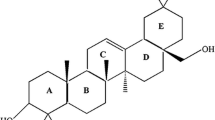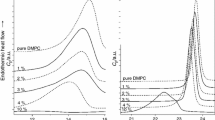Abstract
Purpose. In the present study we examined the effect of the freezing protocol on carboxyfluorescein (CF) retention in liposomes after freeze-drying and rehydration.
Methods. Liposomes were frozen slowly at 0.5°C/min, or quickly by submerging the samples in boiling nitrogen before freeze-drying. The thermal behaviour of the frozen dispersions was analysed by Modulated Temperature Differential Scanning Calorimetry (MTDSC). The dried cakes were analysed by SEM, MTDSC and FTIR. The % encapsulated CF of the (re)hydrated liposomes was determined by fluorimetry after GPC, their vesicle size was measured by the Dynamic Light scattering Technique and their bilayer transition was studied by DSC.
Results. Slow freezing resulted in a markedly higher CF retention after freeze-drying and rehydration as compared to quick freezing. The effect of the freezing rate depended on the lipid composition and was most pronounced for rigid liposomes. The damage caused by quick freezing did not occur after a freezing/thawing cycle. The freezing protocol did not influence the interaction between the phospholipids and the lyoprotectants (sucrose, trehalose or glucose) in the freeze-dried state. However, analysis by DSC of dipalmitoylphosphatidylcholine (DPPC): dipalmitoylphosphatidylglycerol (DPPG) =10:1 and DPPC liposome dispersions showed that the freezing protocol affected the bilayer melting characteristics of these liposomes after freeze-drying and rehydration.
Conclusions. A proper design of the freezing protocol is essential to achieve optimal stability of rigid liposomes during a freeze-drying and rehydration cycle.
Similar content being viewed by others
REFERENCES
E. C. A. Van Winden, N. J. Zuidam, and D. J. A. Crommelin. In (D. D. Lasic and D. P. Papahadjopoulos, eds.) Medical applications of liposomes, Elsevier, In press.
J. H. Crowe and L. M. Crowe. Biochim. Biophys. Acta 939:327–334 (1988).
J. H. Crowe and L. M. Crowe. In (G. Gregoriadis, eds.) Liposome Technology, Vol. I CRC Press, Inc., Boca Raton, FI., 1993.
J. H. Crowe, S. B. Leslie, and L. M. Crowe. Cryobiology 31:355–366 (1994).
G. Strauss, P. Schurtenberger, and H. Hauser. Biochim. Biophys. Acta 858:169–180 (1986).
D. J. A. Crommelin and E. M. G. Van Bommel. Pharm. Res. 1:159–164 (1984).
E. C. A. Van Winden, B. J. H. Deketh, and D. J. A. Crommelin. submitted.
H. Talsma, M. J. Van Steenbergen, and D. J. A. Crommelin. Int. J. Pharm Sci. 77:119–1126 (1991).
B. Wunderlich, Y. Jin, and A. Boller. Thermochim. Acta 238:277–293 (1994).
M. Reading, A. Luget, and R. Wilson. Thermochim. Acta 238:295–307 (1994).
E. Ralston, L. M. Hjelmeland, R. D. Klausner, J. N. Weinstein, and R. Blumenthal. Biochim. Biophys. Acta 649:133–137 (1981).
W. Zhang, E. C. A. Van Winden, and D. J. A. Crommelin. submitted.
E. C. A. Van Winden, and D. J. A. Crommelin. submitted.
E. C. A. Van Winden, H. Talsma, and D. J. A. Crommelin. submitted.
G. Rouser, S. Fluscher, and A. Yamamoto. Lipids 5:494–496 (1970).
Y. Roos, and M. Karel. Int. J. Food Sci. Technol. 26:553–566 (1991).
M. E. Sahagian and H. D. Goff. Thermochim. Acta 246:271–283 (1994).
S. Ablett, M. J. Izzard, and P. J. Lillford. J. Chem. Soc. Faraday Trans. 88:789–794 (1992).
E. Y. Shalaev, and F. Franks. Cryobiology 33:14–26 (1996).
Y. Roos and M. Karel. J. Food Sci. 56 (1991).
R. H. M. Hatley and F. Franks. J. Therm. Anal. 37:1905–1914 (1991).
J. H. Crowe, L. M. Crowe, J. F. Carpenter, A. S. Rudolph, C. A. Wistrom, B. J. Spargo, and T. J. Anchordoguy. Biophys. Acta 947:367–384 (1988).
L. M. Crowe, and J. H. Crowe. Biochim. Biophys. Acta 946:193–201 (1988).
K. L. Koster, M. S. Webb, G. Bryant, and D. V. Lynch. Biochim. Biophys. Acta 1193:143–150 (1994).
W. C. Mobley and H. Schreier. J. Control. Rel. 31:73–87 (1994).
P. T. T. Wong and H. H. Mantsch. Chem. Phys. Lipids 46:213–244 (1988).
N. J. Zuidam, S. S. L. Lee, and D. J. A. Crommelin. Pharm. Res. 12:1761–1768 (1995).
L. I. Viera, S. Alonso-Romanowski, V. Borovyagin, M. R. Feliz, and E. A. Disalvo. Biochim. Biophys. Acta 1145:157–167 (1993).
K. Tanaka, T. Takeda, K. Fuji, and K. Miyama. Chem. Pharm. Bull. 40:1–5 (1992).
G. Cevc (ed.). Phospholipids Handbook, Marcel Dekker, Inc., New York, 1993.
Author information
Authors and Affiliations
Corresponding author
Rights and permissions
About this article
Cite this article
van Winden, E.C.A., Zhang, W. & Crommelin, D.J.A. Effect of Freezing Rate on the Stability of Liposomes During Freeze-Drying and Rehydration. Pharm Res 14, 1151–1160 (1997). https://doi.org/10.1023/A:1012142520912
Issue Date:
DOI: https://doi.org/10.1023/A:1012142520912




